Did you know that the estimated annual cost of workplace conflict in the U.S. is $359 billion? Lost time and productivity quickly add up. Additionally, between the cost of employee attrition, wasted time, poor decision making and lower ROI of labor, a single conflict may cost the company $255,000 for each episode.
Now imagine if things are that costly due to conflict at work, what it’s costing you at home.
Between family members, friends, partners, or loved ones, you may be losing time, money, patience, and peace. Sure, you may be an avid reader of uplifting books that encourage calm, thoughtful dialogue, but it isn’t always easy when emotions are running high.
Let’s face it, when we’re upset, we’re upset! When emotions run high, we don’t always choose the appropriate communication approach to get our point across.
To begin the conflict resolution process, start by taking a step back. Take a moment to separate yourself from the triggering situation so you can avoid reacting with harsh words that you may soon regret. Once you’ve given yourself some space, the following six tips and books will help you proactively, and thoughtfully, manage conflict at home and at work.
Get your facts straight. Start by understanding what happened and what was the cause of 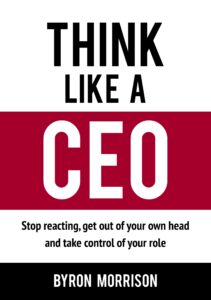 the conflict. Look for the facts, not the emotions. While feelings are certainly important and need to be worked through, they can cloud sound decision making and judgment. Once you’ve identified the facts (not hearsay), then you can prepare your fact-based talking points, negotiable outcomes, and a win-win resolution. Think Like a CEO by Byron Morrison is a great book full of tools to use at work, and at home, to get you out of reactivity mode and into fact mode. Once you have the facts straight, you can thoughtfully manage your reaction and de-escalate conflict.
the conflict. Look for the facts, not the emotions. While feelings are certainly important and need to be worked through, they can cloud sound decision making and judgment. Once you’ve identified the facts (not hearsay), then you can prepare your fact-based talking points, negotiable outcomes, and a win-win resolution. Think Like a CEO by Byron Morrison is a great book full of tools to use at work, and at home, to get you out of reactivity mode and into fact mode. Once you have the facts straight, you can thoughtfully manage your reaction and de-escalate conflict.
Consider all perspectives. Widen your lens and look at the bigger picture, including the third perspective. How is the community around you being affected by the conflict and what is the non-partisan viewpoint? In his book, A Deeper Connection: How to Navigate Conflict and Grow Relationships, John Sherrodd focuses on people and 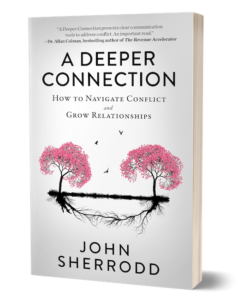 perspectives, helping you to prioritize relationships. When you get out of the emotional weeds, see the bigger picture, and formulate a solution you move forward. Approaching others with compassion and understanding helps minimize their fears, and yours, and opens the door to positive communication.
perspectives, helping you to prioritize relationships. When you get out of the emotional weeds, see the bigger picture, and formulate a solution you move forward. Approaching others with compassion and understanding helps minimize their fears, and yours, and opens the door to positive communication.
Work with your coach. In addition to exploring all angles, coaching focuses on diffusing heated and hurt emotions while developing a strategy for effective communication. Difficult Conversations: How to Discuss What Matters Most by Douglas Stone, Bruce Patton, and Sheila Heen provides a step-by-step process based on years of expert research that coaches you through the process of conducting such conversations. Remember, 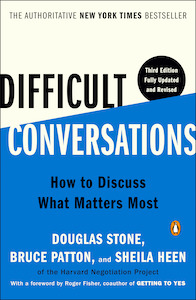 words can be weapons, but they can also heal, so to use them effectively you must choose wisely and employ a neutral tone during delivery.
words can be weapons, but they can also heal, so to use them effectively you must choose wisely and employ a neutral tone during delivery.
Communicate clearly and respectfully. Clear, concise, and fact-based communication can help you navigate conflict. First, consider what medium you are using—text, email or voice—and choose the right approach. When we put things in writing, there is a lot of room for misinterpretation. While this is still a good follow-up approach, it’s probably the worst way to address conflict. Instead, pick up the phone or schedule time with the other party so 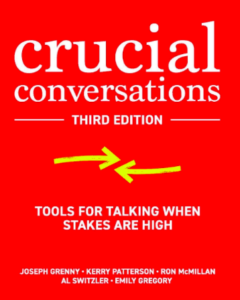 that you can create a safe space for communication and truly listen to one another. The book Crucial Conversations: Tools for Talking When Stakes are High by Joseph Grenny and Kerry Patterson should be your go-to manual for ensuring communication flows smooth and desired outcomes are achieved.
that you can create a safe space for communication and truly listen to one another. The book Crucial Conversations: Tools for Talking When Stakes are High by Joseph Grenny and Kerry Patterson should be your go-to manual for ensuring communication flows smooth and desired outcomes are achieved.
Close the ‘energy’ gap. According to Nate Regier in his book Conflict Without Casualties, “Conflict is simply the energy created by the gap between what we want and what we’re experiencing.” Re-examine the conflict that you are in and look for the ‘what?’ In other words, what is it you 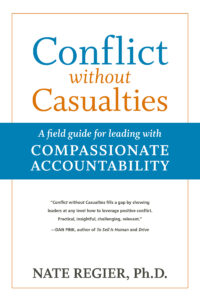 need and what is standing in the way of what you want to achieve? When you identify the obstacle—finances, disagreements, lack of accountability—that is the first step in resolving the negative energy surrounding it and closing the gap.
need and what is standing in the way of what you want to achieve? When you identify the obstacle—finances, disagreements, lack of accountability—that is the first step in resolving the negative energy surrounding it and closing the gap.
Let things go. Finally, keep in mind that not all conflict is bad. Sometimes, minor conflict inspires creative solutions or helps root out potential obstacles in the way of success. Conflict helps illuminate and strengthen differences that make up the healthy recipe for team success. And don’t go looking for conflict. If it isn’t yours don’t get involved unless it’s only to neutrally mediate.
I hope this article provided you with a few applicable ideas. I would be honored if you shared this on social media. And speaking of sharing, please share your own ideas and experiences below. Together, we can build an uplifting community that focuses on supporting each other’s success.
Images Courtesy of John Sherrodd, McGraw Hill, Berrett-Koehler Publishers, Penguin Random House, and Byron Morrison.


No comments yet.